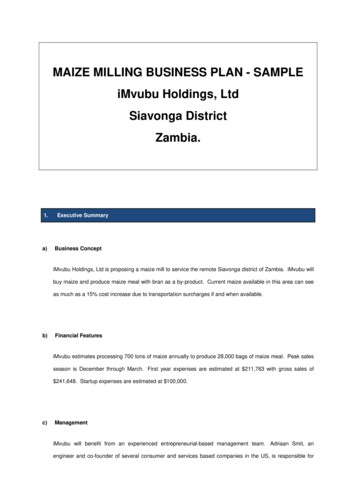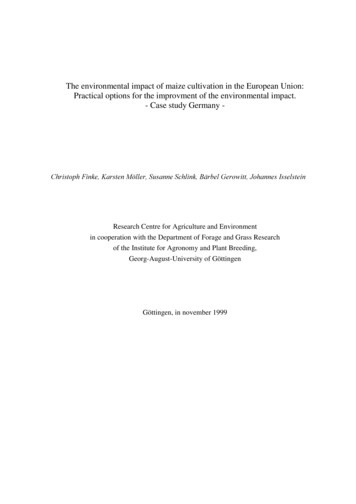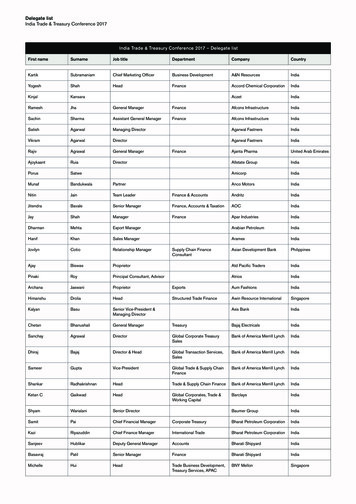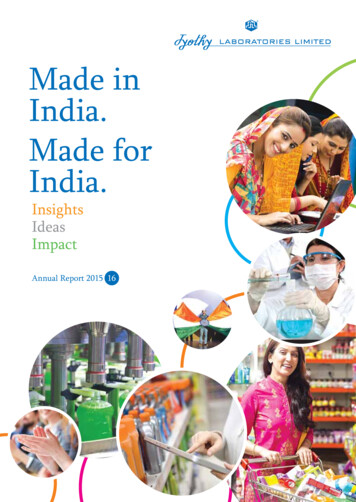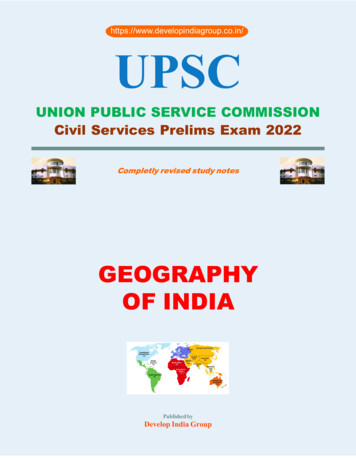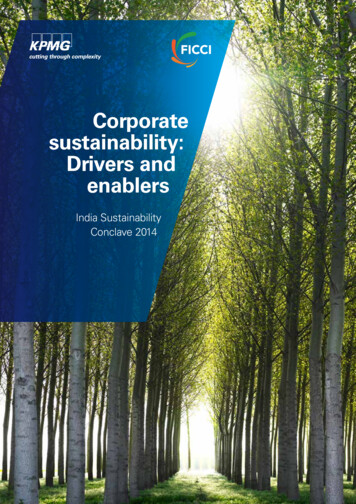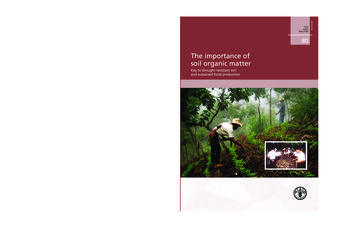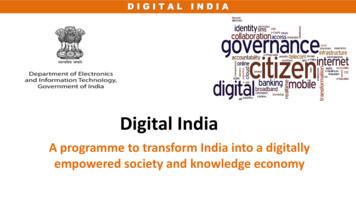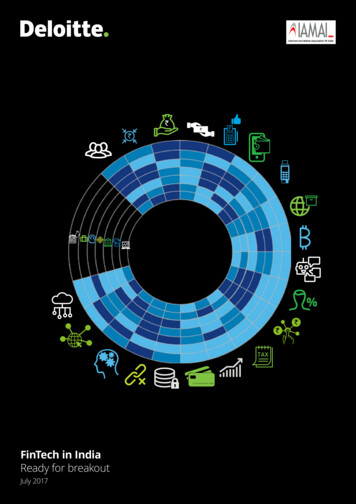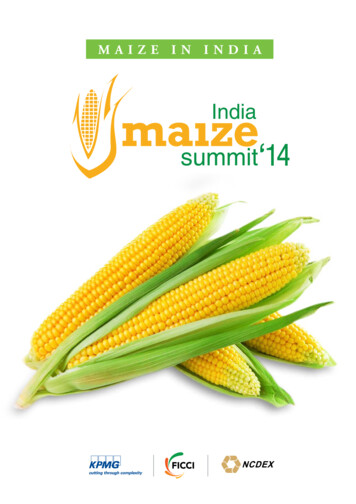
Transcription
MAIZE IN INDIA
ContentsForeword02Global Maize Scenario06 Land Area Under Maize Cultivation and YieldsTop Maize Producing CountriesTop Maize Exporting / Importing CountriesIndian Maize Scenario Land Area Under Cultivation and YieldsState Wise Maize CultivationMaize Productivity ComparisonIndian Maize ConsumptionIndian Maize ExportsMinimum Support PricesStock to Consumption RatioIndian Maize Balance SheetAverage Annual GrowthPost Harvest Management & LossesChallenges and the Way-Forward 10Key concernsWay Ahead22
Foreword - FICCIMaize is one of the most important cereal crops of the world and contributes to food security in most ofthe developing countries. In India, maize is emerging as third most important crop after rice and wheat. Itsimportance lies in the fact that it is not only used for human food and animal feed but at the same time it is alsowidely used for corn starch industry, corn oil production, baby corns etc.Corn production has nearly doubled from around 12.0 million tons in the early 2000s to around 22 milliontons today. This remarkable production growth has been largely driven by adoption of single cross hybrids inthe late 1980’s and continuous demand in domestic and export market. The increasing use of maize as feed,increasing interest of the consumers in nutritionally enriched products and rising demand for maize seed are thecore driving forces behind emerging importance of maize crop in India.However, despite the production strength, Indian corn yields are significantly below the yields in major cornproducing countries. There is immense scope for an increase in India’s corn production by increasing area underhybrids, adoption of better genetics and improved agronomic practices.Driven by structural changes in agriculture and food consumption patterns, maize is bound to hold its shareas an important cereal crop in future. In current scenario, the need is to focus not only on production andproductivity but also on building a competitive maize supply chain. The study on maize is an effort to bring forethe global and domestic scenario of maize and issues confronting the maize supply chain.FICCI has always thrived in providing thought leadership. It is our strong belief that this report would behelpful in focusing India’s potential in the maize sector and immensely useful to various stakeholders in themaize industry in identifying the critical constraints and challenges confronting the industry and is instrumentalin designing the possible interventions by the market players and the Government.Dr. A. Didar Singh,Secretary General,FICCI 2014 KPMG India Pvt Ltd, an Indian Partnership and a member firm of the KPMG network of independent memberfirms affiliated with KPMG International Cooperative (“KPMG International”), a Swiss entity. All rights reserved.INDIA MAIZE SUMMIT 2014 2
Foreword -NCDEXThe global maize revolution is characterized by new technology, consumer demand and industrial farming.Maize has become is today used as an important raw material in food processing, poultry, dairy, meat andethanol industry and along with its traditional uses makes it one of the fastest growing cash crops in the world.Two factors responsible for enormous success of maize as an industrial ingredient are its molecular versatilityand development of high yielding seed varieties. While former made breaking down and reassembling of maizestarch molecules easy, the latter has increased yields by 40% in last 20 years. Traditionally, most maize wentto livestock as feed but modern technology has helped it find new uses in food industry with animal proteinand starch driving global demand today. International maize trade is now larger than international rice trade.USA, Brazil, Argentina and India are the major exporters of maize while Japan, South Korea, Mexico are themajor importers. China, having turned a net importer recently, has launched a maize revolution using moderntechnology and high yielding varieties of seeds.India is also on the threshold of a similar maize revolution. The introduction of new hybrid seeds that cansurvive low winter conditions, off-season diseases and pests with high productivity has made maize a profitablealternative even for small farmers in UP, Bihar, Andhra Pradesh and Karnataka. Hybrid seeds are also responsiblefor making maize a pan-India crop. Increase in rabi production, along with increased acreage and supply, hasturned Indian into a net exporter. Rise in rural incomes has provided further fillip to demand for cereals andprotein foods and shifted poultry farms from backyards to organized business.Transparent price signals and scientific grading have contributed in a large way to the farm-gate efficiency ofmaize. NCDEX futures trading in the last decade helped develop the value chain and physical market for maizein India by giving advance price signals and allowing risk management. The technology platform created by theexchange has enabled integration of markets across geographies and has ensured wider participation. There hasbeen a significant improvement in the warehousing infrastructure in the country, empowering maize farmerswith ‘waiting power’, which leads to better price realization. Futures trading has also benefited poultry farmersand starch manufacturers working with thin margins to lock in prices of their raw material. Tangible benefitsof futures trading have also prompted state governments to encourage electronic trading in physical markets aswell, especially in Karnataka where the state government, in partnership with NCDEX, has created a UnifiedMarket Platform linking physical markets. NCDEX has been playing a pivotal role in providing a platform forthe entire value chain and has brought in its fold farmers, aggregators, traders, retail chains, exporters, foodprocessors, agricultural companies and consumers.Initiatives of NCDEX has brought in the corn revolution in Bihar. Engagaing with the state governments,NCDEX has introduced innovations in warehousing like developing the revolving basis centres for deliveryof maize produce. Thus, Gulabbaug in Bihar that has a bumper rabi crop and Nizamabad in Andhra Pradeshgiving a robust kharif harvest not only serve as delivery centres but have also helped in efficient price discoveryto farmers along with reducing the crop damage.This report provides a framework to explore the opportunities in Indian maize crop. It is an apt platform todeliberate on the challenges as well as to suggest reforms to strengthen the maize value chain. We hope it willcompliment efforts of various stakeholders in making agriculture based systems productive and sustainable.Samir Shah,MD & CEO,NCDEX 2014 KPMG India Pvt Ltd, an Indian Partnership and a member firm of the KPMG network of independent memberfirms affiliated with KPMG International Cooperative (“KPMG International”), a Swiss entity. All rights reserved.INDIA MAIZE SUMMIT 2014 4
01Global Maize Scenario
GLOBAL MAIZE SCENARIOGlobal maize production has grown at aCAGR of 3.4 per cent over the last ten yearsfrom 716 MnMT in 2004-05 to 967 MnMTin 2013-14Global Maize -07-3%6%CAGR 3.4%1,000Mn 678868632011-122012-136004002000Source: USDA2013-14Y-o-Y increase in productionMaize is a cereal crop which is cultivated widely throughout the world and has the highest production amongall the cereals. The worldwide production of maize was more than 960 MnMT in 2013-14. It is an importantfood staple in many countries and is also used in animal feed and many industrial applications. The crop hastremendous genetic variability, which enables it to thrive in tropical, subtropical, and temperate climates.Global production of maize has grown at a CAGR of 3.4 per cent over the last ten years, from 717 MnMT in2004-05 to 967 MnMT in 2013-14.The area under maize cultivation in the period has increased at a CAGR of 2.2 per cent, from 146 Mn hectarein 2004-05 to 177 Mn hectare in 2013-14, the remaining increase in production is due to increase in yield.Productivity of maize has increased at a CAGR of 1.2 per cent, from 4.9 MT/hectare in 2004-05 to 5.5 MT/hectare in 2013-14.Land Area Under Maize Cultivation and Yields%CAGR -06Source: USDA*KPMG India Private LimitedINDIA MAIZE SUMMIT 407 150171MT/hectareMn 2Area Harvested (Mn HA)2012-132013-144.4Area Harvested (Mn HA) 2014 KPMG India Pvt Ltd, an Indian Partnership and a member firm of the KPMG network of independent memberfirms affiliated with KPMG International Cooperative (“KPMG International”), a Swiss entity. All rights reserved.
GLOBAL MAIZE SCENARIOUSA is the largest producer of maize in theworld, followed by China and Brazil; USA isalso the largest exporter of maizeUnited States is the largest maize producer and also has a large surplus, which also makes it the largest maizeexporter. Brazil, Ukraine and Argentina are the other key maize producing countries behind USA. The fourcountries together account for 80-85% of the total exports in maize.Maize is by far the largest component of global coarse-grain trade. Most of the maize that is traded is used forfeed; smaller amounts are traded for industrial and food uses.Japan has negligible maize production and has consistently been the top maize importer in the world. 90 percent of Japan’s maize requirements comes from USA and another 8-9 per cent from Argentina and Brazil. Chinaand Mexico, though being amongst the top maize producing nations, are also top importers.Top Maize Producing Countries, 2013-14United States 37%Others 17%Mexico 2%India 2%Argentina 3%Ukraine 3%European Union7%Source: USDAChina 22%Brazil 7% 2014 KPMG India Pvt Ltd, an Indian Partnership and a member firm of the KPMG network of independent memberfirms affiliated with KPMG International Cooperative (“KPMG International”), a Swiss entity. All rights reserved.INDIA MAIZE SUMMIT 2014 8
GLOBAL MAIZE SCENARIOMexico, due to its close proximity to USA, imports 99 per cent of its maize from USA. While Mexico hasconsistently been amongst the top importers; China has become a maize deficit country over the past five yearsdue to the high demand growth from feed industry.However, there has been a declining trend in maize exports from USA. The reason for decrease in exports fromUSA is due to maize being consumed locally for production of ethanol. The rising demand for maize anddecrease in exports from USA has led to an increase in prices globally.Top Maize Exporting CountriesTop Maize Importing Countries100%80%Per %30%3%9%20%26%8%5%36%33%10%10%20%2009-10 2010-11 2011-12 2012-13 2013-14United 30%3%20%9%50%5%Per cent90%60%17%15%15%10%14%2009-10 2010-11 2011-12 2012-13 2013-14JapanMexico European UnionKorea, SouthEgyptChinaSource: USDA9 INDIA MAIZE SUMMIT 2014 2014 KPMG India Pvt Ltd, an Indian Partnership and a member firm of the KPMG network of independent memberfirms affiliated with KPMG International Cooperative (“KPMG International”), a Swiss entity. All rights reserved.
02Indian Maize Scenario
INDIAN MAIZE SCENARIOProduction of maize in India has increased ata CAGR of 5.5 per cent from 14 MnMT in2004-05 to 23 MnMT in 2013-14India Maize 2013-14CAGR 5.520Mn 007-082008-09171050Source: USDA2009-10Y-o-Y increase in productionMaize is grown throughout the year in India. It is predominantly a kharif crop with 85 per cent of the area undercultivation in the season. Maize is the third most important cereal crop in India after rice and wheat. It accountsfor 9 per cent of total food grain production in the country.Maize production in India has grown at a CAGR of 5.5 per cent over the last ten years from 14 MnMTin 2004-05 to 23 MnMT in 2013-14. During 2009-10 there was a decline in production primarily due todrought that affected production of kharif crops in the country. The area under maize cultivation in the periodhas increased at a CAGR of 2.5 per cent from 7.5 Mn hectare in 2004-05 to 9.4 Mn hectare in 2013-14, theremaining increase in production is due to increase in yield. Factors such as adaptability to diverse agro-climaticconditions, lower labour costs and lowering of water table in the rice belt of India have contributed to theincrease in acreage.Productivity of maize (yield) has increased at a CAGR of 2.9 per cent from 1.9 MT/hectare in 2004-05 to 2.5MT/hectare in 2013-14. Introduction of Single cross hybrid (SCH) seeds coupled with adequate rainfall in2007-08 contributed to 20 per cent increase in yield.Land Area Under Maize Cultivation and YieldsCAGR 00.02004-052005-062006-072007-08Source: Source: USDA, Directorate of Economics and Statistics,Department of Agriculture and Cooperation11 3.0MT/hectareMn hectare8.08.38.6INDIA MAIZE SUMMIT 20142008-092009-102010-112011-12Area Harvested (Mn HA)2012-132013-140.0Yield (MT/HA) 2014 KPMG India Pvt Ltd, an Indian Partnership and a member firm of the KPMG network of independent memberfirms affiliated with KPMG International Cooperative (“KPMG International”), a Swiss entity. All rights reserved.
INDIAN MAIZE SCENARIOProduction of maize in India is dominatedby Andhra Pradesh and Karnataka whichcontributes to 38 per cent of the totalproductionState Wise Maize Acreage and Production, 2010-11Rajasthan1.1 Mnhectare;2.1 MnMTBihar0.6 Mnhectare;1.4 MnMTMadhya Pradesh0.8 Mnhectare;1 MnMTMaharashtra0.9 Mnhectare;2.6 MnMTAndhra Pradesh0.7 Mnhectare;4 MnMTKarnataka1.3 Mnhectare;4.4 MnMTMaize Producing StatesMaize production is dominated by Andhra Pradesh and Karnataka, producing 38 per cent of India’s maize in2010-11.Nine states viz. Karnataka, Andhra Pradesh, Tamil Nadu, Rajasthan, Maharashtra, Bihar, Uttar Pradesh ,Madhya Pradesh and Gujarat account for 85 per cent of India’s maize production and 80 per cent of area undercultivation.Area under hybrid seeds in 2010-11 is estimated to be 60 per cent of the total area under maize cultivation.Andhra Pradesh has the highest yield followed by Tamil Nadu due to majority of the area being covered underSingle Cross Hybrids (SCH). 2014 KPMG India Pvt Ltd, an Indian Partnership and a member firm of the KPMG network of independent memberfirms affiliated with KPMG International Cooperative (“KPMG International”), a Swiss entity. All rights reserved.INDIA MAIZE SUMMIT 2014 12
INDIAN MAIZE SCENARIOState Wise Maize Cultivation Statistics, 2010-11StateArea under Hybrids *Area under cultivationProductionYieldPer centMn HectaresMn tonneTonnes / Madhya Pradesh16%0.811.2Maharashtra100%0.92.62.9Andhra Pradesh100%0.745.3Uttar .81.6Tamil Nadu100%0.214.5Ohers60%1.53.32.1All India60%8.621.72.5Source: Directorate of Economics and Statistics, Department of Agriculture and CooperationNote: * Includes approximate area under Single Cross hybrids, three way cross and Double cross hybrid seedsIndia’s yield at 2.5 MT/hectare is less thanhalf the global average of 5.5 MT/hectareMaize Productivity Comparison, .66.06.04.84.0Scope forimprovement12.085% BT15% SCH5.52.52.00.0United StatesEuropeanUnionChinaBrazilIndiaWorldArea under type of seedsSource: USDA,USA has the highest productivity when compared with the global average of 5.5 MT/hectare due to 85 percent of the area under BT-SCH and remaining 15 per cent under SCH seeds backed by temperate climate andlong duration crop. The yield in EU nations is as high as 6.6 MT/hectare due to 100 per cent area under SCH,temperate climatic conditions and long duration crop. The yield in China is low when compared to EU nationsdue to sub-tropical climate and medium duration crop. Brazil has lower yield due to dependence on rainfall andtropical climatic conditions.The differences in yield across the globe is mainly due to environmental, technological, economic andorganizational factors. In most developed countries the climate is temperate; likewise they use sufficient inputsand a well mechanized system for the maize production.In India, the yield is half of the global average. Constraints for low productivity include: Climatic conditions resulting in drought/excess water associated with increased pressure of diseases/pests Cultivation in kharif is mainly under rain-fed conditions on marginal lands with inadequacy in irrigation Only about 30 per cent of the area is under SCH. Lack of development of single cross hybrid technology, which is a keyto higher productivity gains like USA, China and other countries Limited adoption of improved production-protection technology Deficiencies in the production and distribution system of quality seed Small farm holdings and limited resource availability with farmers13 INDIA MAIZE SUMMIT 2014 2014 KPMG India Pvt Ltd, an Indian Partnership and a member firm of the KPMG network of independent memberfirms affiliated with KPMG International Cooperative (“KPMG International”), a Swiss entity. All rights reserved.
INDIAN MAIZE SCENARIOMaize consumption has increased at a CAGRof 3.6 per cent over the last five years; poultryfeed accounts for 50 per cent of maizeconsumptionIndia Maize ConsumptionCAGR .05.00.02008-092009-102010-112013-14Source: USDA, KPMG AnalysisMaize consumption in India has grown at a CAGR of 4 per cent over the last ten years from 14 MnMT in2004-05 to 19MnMT in 2013-14. There was a decrease in domestic consumption in 2009-10 primarily due tothe drought that lead to decline in production.End-use for maizeMaize consumption in India has grown at a CAGR of 4 per cent over the last ten years from 14 MnMT in2004-05 to 19MnMT in 2013-14. There was a decrease in domestic consumption in 2009-10 primarily due tothe drought that lead to decline in production.Most of the maize in India is used in the poultry feed industry. Poultry industry is heavily dependant on maizeas it forms 50-60 per cent of the input required for broiler feed and 25-35 per cent of the input requiredfor layer feed. Maize is the preferred source of energy in feed when compared with other substitutes due toavailability, higher energy and price economics. Poultry feed’s share has remained around 45-50 per cent of thetotal demand for maize in the country over the past 4-5 years. 2014 KPMG India Pvt Ltd, an Indian Partnership and a member firm of the KPMG network of independent memberfirms affiliated with KPMG International Cooperative (“KPMG International”), a Swiss entity. All rights reserved.INDIA MAIZE SUMMIT 2014 14
INDIAN MAIZE SCENARIOEnd-Use Split, India, 2012-13End-Use Split, Global, 2012-13Food Processing,Brewry & Others 7%Feed 61%Poultry47%Cattle Feed14%Food17%DirectConsumption20%Starch 12%Industrial Purpose 22%Source: IMA, KPMG AnalysisMaize is the basic raw material required for manufacturing starch and constitutes 60-70 per cent of thetotal operating costs. Maize has 60-65 per cent starch content, hence cannot be easily substituted by othercommodities.Historically maize was used more for local consumption and less for commercial use. Maize utilized for directhuman consumption has reduced over the years and is expected to further reduce due to rising income levelswhich has made preferred cereals like wheat and rice more affordable, increasing commercial demand frompoultry and starch industries leading to higher farmer realization.Developed countries like USA and European nations have a very low ratio of maize going towards direct maizeconsumption as most of the maize goes toward production of feed, starch and ethanol. Maize is consumeddirectly as food primarily in developing countries of Africa and Central America.Economic development in the country is expected to shift India’s maize consumption pattern to that ofdeveloped countries and result in a further drop in direct consumption of maize.15 INDIA MAIZE SUMMIT 2014 2014 KPMG India Pvt Ltd, an Indian Partnership and a member firm of the KPMG network of independent memberfirms affiliated with KPMG International Cooperative (“KPMG International”), a Swiss entity. All rights reserved.
INDIAN MAIZE SCENARIOProcurement through the trader and brokernetwork is the most prominent channeladopted by the end users for procuring maizeModel 1 – Procurement Through the Trader NetworkIllustrativeCost ofCultivationFarmer Realizationat MandiTraderPurchase PriceEnd UserPurchase PriceINR 940/QuintalINR 1,100/QuintalINR 1,122/QuintalINR 1,292/QuintalModel 2 – Procurement through the broker networkIllustrativeBrokerCost ofCultivationFarmer Realizationat MandiTraderPurchase PriceEnd UserPurchase PriceINR 940/QuintalINR 1,100/QuintalINR 1,122/QuintalINR 1,294/QuintalDifferential in price of INR 2/Quintal,if procured through broker networkModel 3 – Procurement through farmersIllustrativeCost ofCultivationFarmer Realizationat MandiEnd UserPurchase PriceINR 940 / QuintalINR 1,100 / QuintalINR 1,245 / QuintalProcurement directly from farmers could result in a saving of approximately INR 50/Quintal, but is not aprominent model in the country today due to factors such as: Payment of cash to farmers Credit period of 15-30 days provided by traders Concerns around continuity of supply from farmers Problems faced managing multiple farmers due to fragmented land holdingsSource: KPMG (KPMG India Pvt. Ltd.) Analysis 2014 KPMG India Pvt Ltd, an Indian Partnership and a member firm of the KPMG network of independent memberfirms affiliated with KPMG International Cooperative (“KPMG International”), a Swiss entity. All rights reserved.INDIA MAIZE SUMMIT 2014 16
INDIAN MAIZE SCENARIOExport of maize has increased significantlyover the years; Indonesia, Vietnam andMalaysia are the key export destinationsIndia Maize Exports (MnMT)CAGR 3.521%3.015%16%1.920%13%12%8%10%% of productionMnMT4.030%4.75%4%3%0%2004-05 2005-06 2006-07 2007-08 2008-09 2009-10 2010-11 2011-12 2012-13 2013-14ExportsSource: USDAIndia key maize export destination, 2012-13Global key maize importers, 2012-13China 3%Others 7%Bangladesh 2%Nepal 3%Exports as a % of ProductionEgypt 5%Indoensia33%Taiwan8%Others 52%Korea,South 8%EuropeanUnion 11%Mexico 6%Malaysia 20%Source: Department of CommerceVietnam 27%Japan 15%Source: USDAIndia has witnessed a jump in maize exports from 2007-08. The increase in export volumes is a result ofincreased production, higher realization and demand for maize from international markets. Export volumedeclined during the period 2009-2011 due to drought conditions leading to low production. Increase localdemand for maize from poultry and starch industries, within India, and application in diversified industriessuch as alcoholic beverages, bio-fuel, processed food, corn oil, etc., has kept maize prices relatively steady.Exports have declined in 2013-14 due to weak export demand which is due to relatively weak global prices onimproved supplies from other competing locations.Maize currently accounts for 22 per cent of total cereal exports from the country. Declining exports from USAand price parity offered by Indian maize provides an opportunity to supply maize to importing countries withinAsia.Amongst the top importing countries, Japan, Korea and China are both much closer to India than USA,Brazil and Argentina (top exporting countries). India could have a cost advantage due to lower shipping costs.Malaysia, Vietnam, Philippines, Indonesia are the other Asian countries which import maize and the highdemand in these countries is expected to increase their maize import quantity.17 INDIA MAIZE SUMMIT 2014 2014 KPMG India Pvt Ltd, an Indian Partnership and a member firm of the KPMG network of independent memberfirms affiliated with KPMG International Cooperative (“KPMG International”), a Swiss entity. All rights reserved.
INDIAN MAIZE SCENARIOThe Government has been providing pricesupport mechanism to encourage farmers togrow maizeMinimum Support Prices (MSP)INR per urce: Department of food and public distribution, KPMG AnalysisPaddy2013-14MaizeBarleyGovernment has been providing price support mechanism to encourage farmers to grow maize as it has readyuse in starch and feed meal industries. For the first time ever, the government has fixed the MSP of maize for2013-14 crop season at Rs 1,310 per quintal, which is same as that for common paddy, with a view to encouragefarmers to plant more maize replacing paddy. Maize has also seen the highest CAGR of 13.3 per cent in MSPover the last years as compared to others crops.Groundwater tables can be greatly enhanced if maize cultivation is promoted in place of paddy as it requires justOne fifth* of the total water required to grow paddy and gives much higher returns to the farmers.The crop has been included in the government’s INR 500 crore crop diversification strategy for North Indianstates of Punjab, Haryana and western Uttar Pradesh.Annual maize prices have been following the MSP declared by the Government, as can be seen from the graphbelow.Maize Prices and MSP1,3261,4001,172INR per Source: CMIE database, Department of food and public distribution,*Commission for Agriculture Costs and Price 2014 KPMG India Pvt Ltd, an Indian Partnership and a member firm of the KPMG network of independent memberfirms affiliated with KPMG International Cooperative (“KPMG International”), a Swiss entity. All rights reserved.2011-122012-13MSP2013-14Annual Average PriceINDIA MAIZE SUMMIT 2014 18
INDIAN MAIZE SCENARIOStock to consumption ratio for Indiaincreased from 3.7 per cent in 2004-05 to 6.6per cent in 2013-14 vis-à-vis global average of16.3 per cent in 2013-14Stock to Consumption Ratio India versus 12011-12Source: USDA2012-13India2013-14WorldIndia Maize Balance SheetFigures ConsumptionEnding StocksStock urce: USDA19 INDIA MAIZE SUMMIT 2014 2014 KPMG India Pvt Ltd, an Indian Partnership and a member firm of the KPMG network of independent memberfirms affiliated with KPMG International Cooperative (“KPMG International”), a Swiss entity. All rights reserved.
INDIAN MAIZE SCENARIOGiven the increasing thrust placed on maizeby the government, maize has witnessedthe highest growth in acreage, as well asproduction over the last ten yearsAverage Annual Growth Rates (per cent) of Area, Production and Yield of Principal CropsCAGR (2004-05 to 2.30%Source: USDAThere has been an increasing trend towards substituting other coarse cereals with maize. Increasing consumptionand exports, government incentives, etc. have given a push to maize production.Maize recorded the highest annual growth rate of 2.5 per cent in the area as well as 5.5 per cent in productionduring the period 2004-05 to 2013-14. Yield has also seen a high growth rate of 2.8 per cent as compared toother cereals. Other major coarse cereals such as millet and sorghum displayed a negative growth in area duringthe same period.Government has appointed an inter-ministerial panel on crop diversification to help farmers look beyondpaddy, which consumes huge amount of water, fertilizer and power. By cultivating maize, farmers can protectthe worsening quality of soil, save 90 per cent of water and 70 per cent of power as compared to paddy and earnfar more than they are earning through paddy and wheat.Source: Punjab Agricultural University 2014 KPMG India Pvt Ltd, an Indian Partnership and a member firm of the KPMG network of independent memberfirms affiliated with KPMG International Cooperative (“KPMG International”), a Swiss entity. All rights reserved.INDIA MAIZE SUMMIT 2014 20
INDIAN MAIZE SCENARIOImprovement in supply chain, use of properdrying techniques and efficient storage andhandling can help reduce post-harvest lossesPost-harvest management and lossesPost- harvest management can be defined as methods and techniques applied to increase the life and retainproduce.Post-harvest loss (PHL) is the loss of grains between harvest and consumption. PHL happens at every stage ofthe supply chain, but in developing countries losses are the most significant. Following harvest, about 60-70 percent of food grain is stored on farms for variable periods, normally in traditional structures and at dangerouslyhigh moisture levels. This makes them particularly vulnerable to infestations of pests and micro-organisms.Significant losses also occur during processing. Most pr
Maize has become is today used as an important raw material in food processing, poultry, dairy, meat and ethanol industry and along with its traditional uses makes it one of the fastest growing cash crops in the world. Two factors responsible for enormous success of maize
